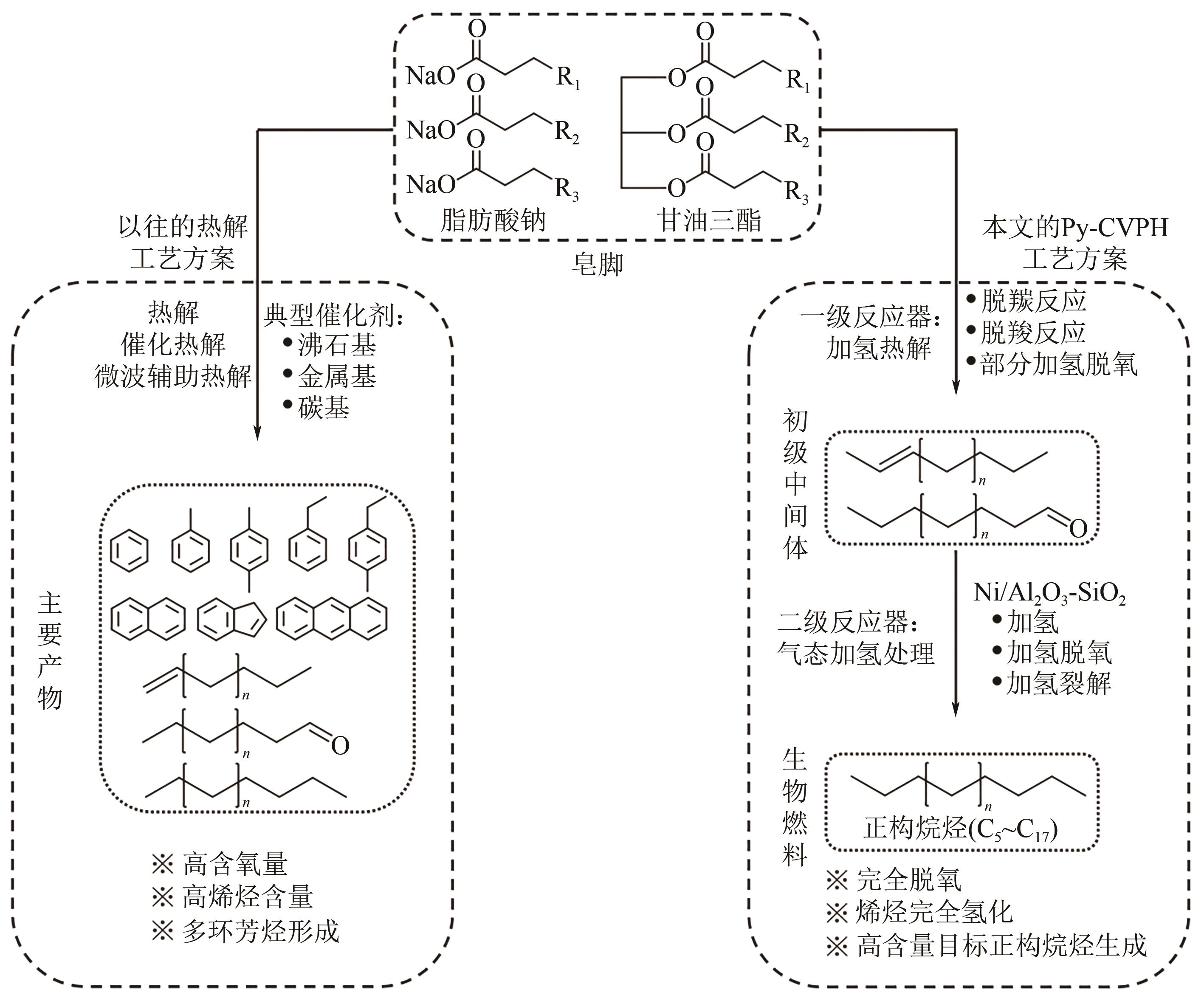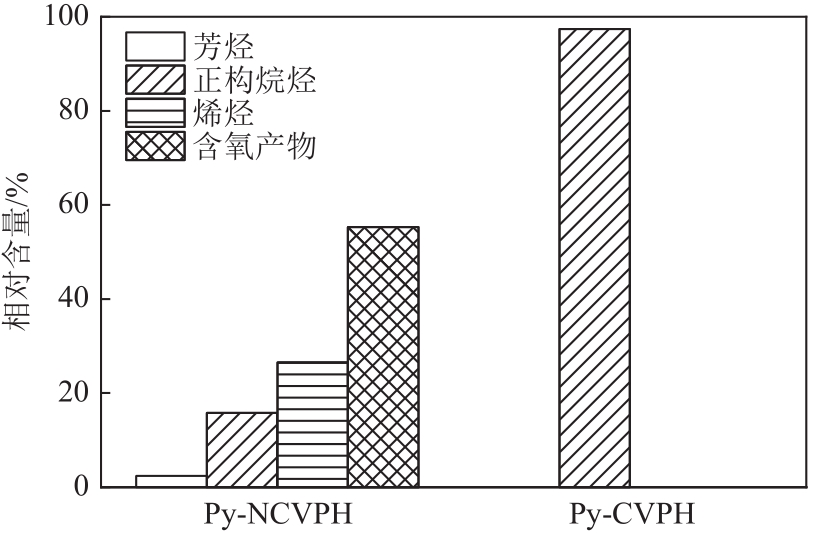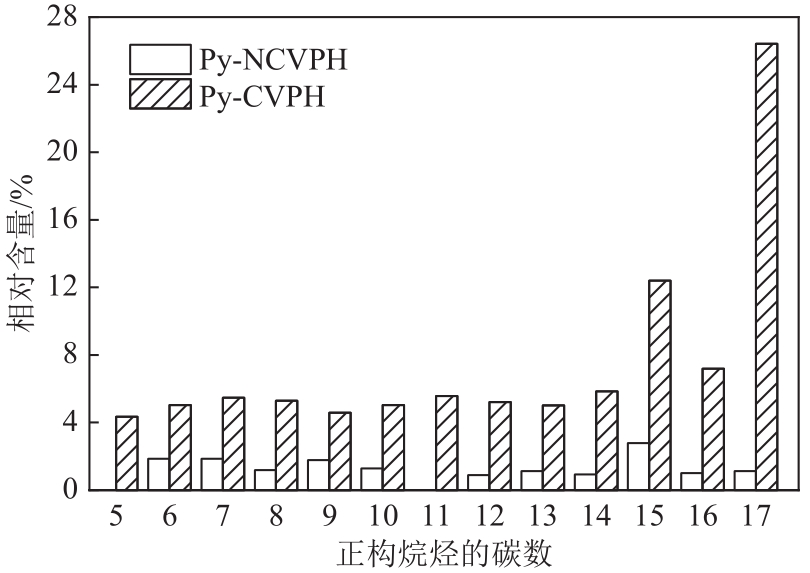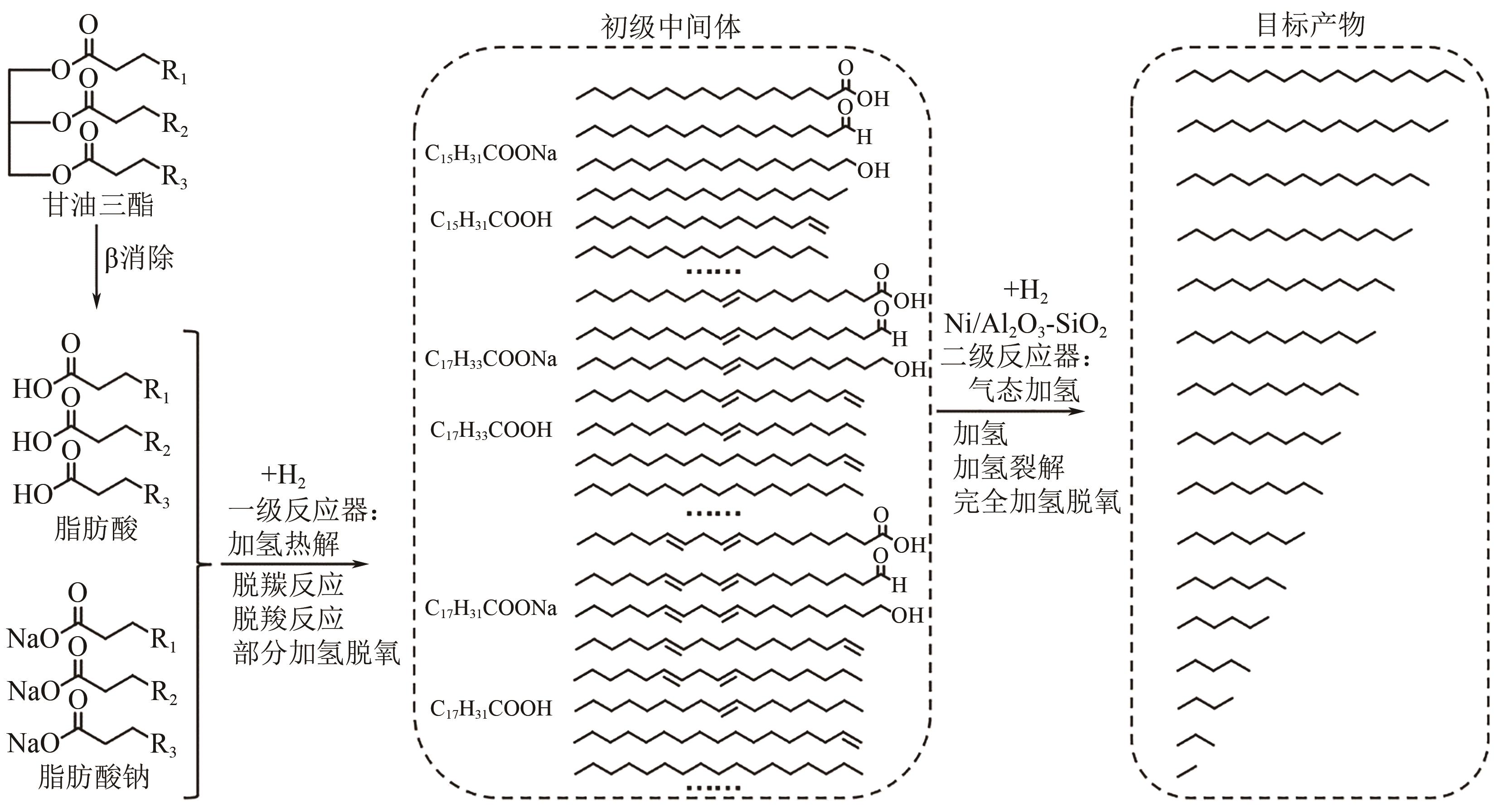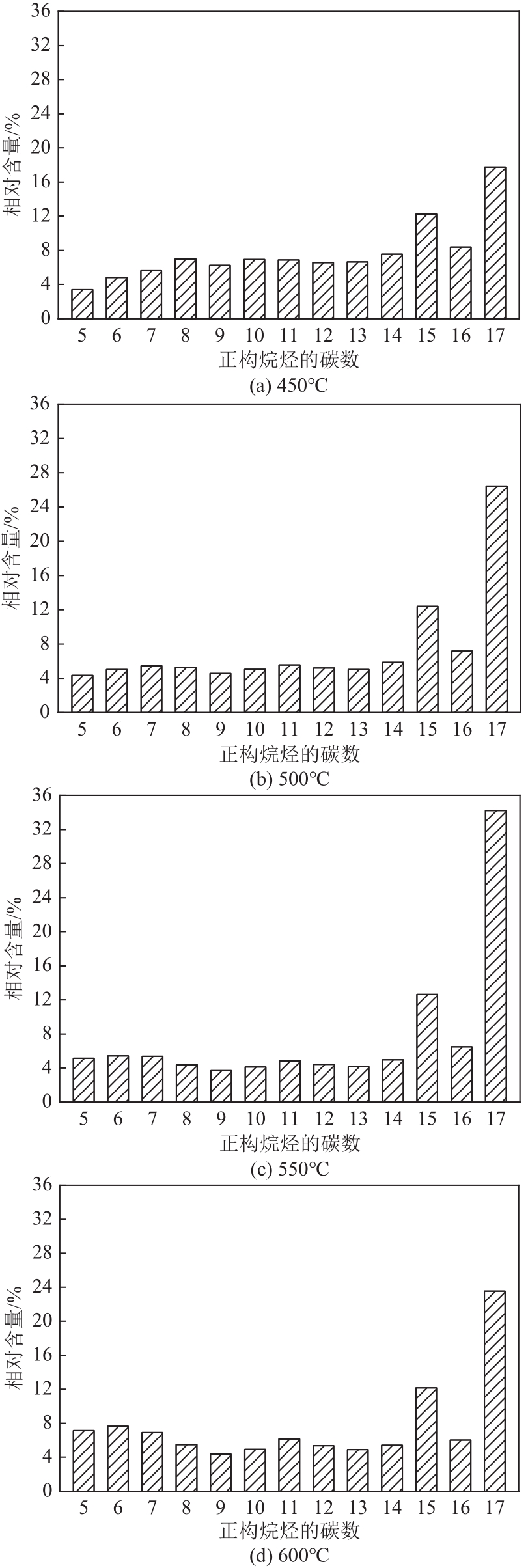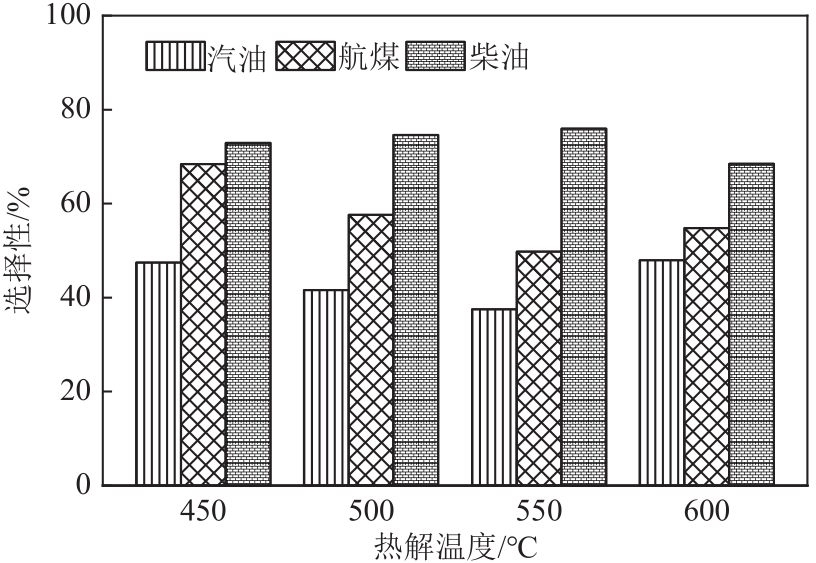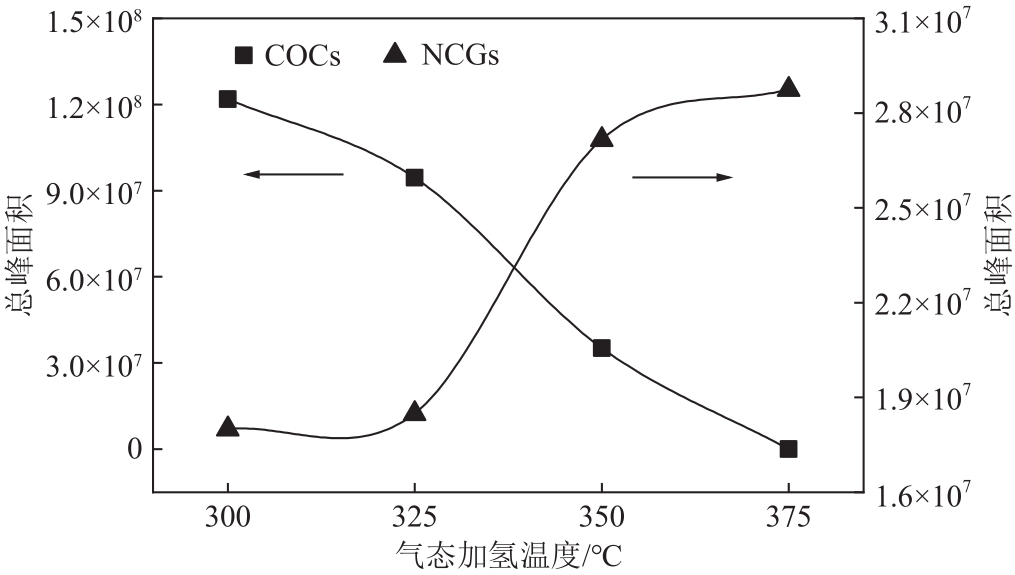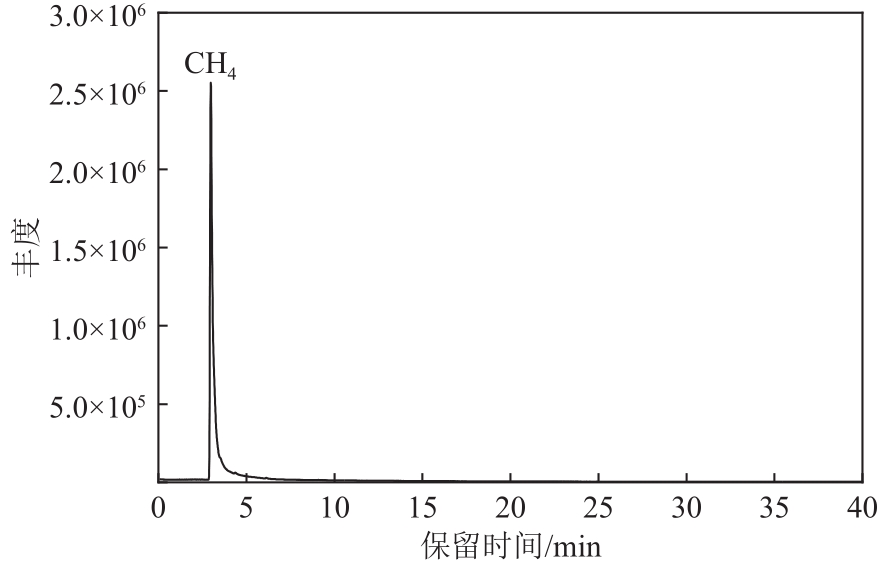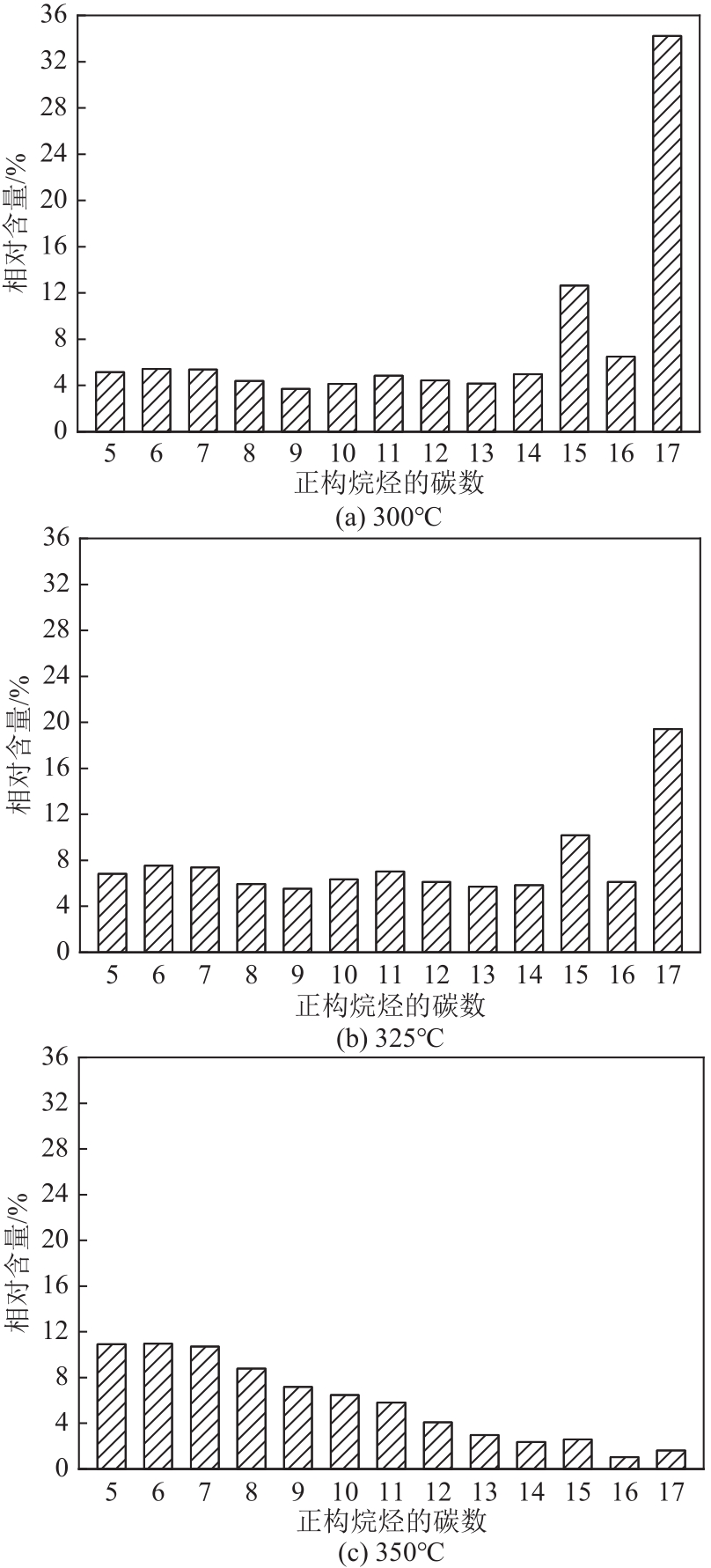Chemical Industry and Engineering Progress ›› 2023, Vol. 42 ›› Issue (6): 2874-2883.DOI: 10.16085/j.issn.1000-6613.2022-1500
• Energy processes and technology • Previous Articles Next Articles
Producing biofuels from soapstock via pyrolysis and subsequent catalytic vapor-phase hydrotreating process
LI Dongxian1( ), WANG Jia1,2(
), WANG Jia1,2( ), JIANG Jianchun1,2
), JIANG Jianchun1,2
- 1.College of Chemical Engineering, Nanjing Forestry University, Nanjing 210037, Jiangsu, China
2.Institute of Chemical Industry of Forest Products, Chinese Academy of Forestry, Nanjing 210042, Jiangsu, China
-
Received:2022-08-15Revised:2022-10-14Online:2023-06-29Published:2023-06-25 -
Contact:WANG Jia
皂脚热解-催化气态加氢制备生物燃料
- 1.南京林业大学化学工程学院,江苏 南京 210037
2.中国林业科学研究院林产化学工业研究所,江苏 南京 210042
-
通讯作者:王佳 -
作者简介:李栋先(1996—),男,硕士研究生,研究方向为有机固废热化学转化。E-mail:ldx@njfu.edu.cn。 -
基金资助:国家自然科学基金(52006106);国家重点研发计划(2019YFB1504001)
CLC Number:
Cite this article
LI Dongxian, WANG Jia, JIANG Jianchun. Producing biofuels from soapstock via pyrolysis and subsequent catalytic vapor-phase hydrotreating process[J]. Chemical Industry and Engineering Progress, 2023, 42(6): 2874-2883.
李栋先, 王佳, 蒋剑春. 皂脚热解-催化气态加氢制备生物燃料[J]. 化工进展, 2023, 42(6): 2874-2883.
share this article
Add to citation manager EndNote|Ris|BibTeX
URL: https://hgjz.cip.com.cn/EN/10.16085/j.issn.1000-6613.2022-1500
| 元素质量分数/% | 脂肪酸组成/% | ||||||||
|---|---|---|---|---|---|---|---|---|---|
| C | H | O① | N | 棕榈酸 | 油酸 | 亚油酸 | 亚麻酸 | 硬脂酸 | 其他 |
| 71.2 | 11.7 | 16.9 | 0.2 | 10.1 | 31.7 | 32.4 | 11.4 | 5.7 | 8.7 |
| 元素质量分数/% | 脂肪酸组成/% | ||||||||
|---|---|---|---|---|---|---|---|---|---|
| C | H | O① | N | 棕榈酸 | 油酸 | 亚油酸 | 亚麻酸 | 硬脂酸 | 其他 |
| 71.2 | 11.7 | 16.9 | 0.2 | 10.1 | 31.7 | 32.4 | 11.4 | 5.7 | 8.7 |
| 1 | 罗兰, 陈红莉, 唐辉, 等. 棉油皂脚酸化油脂肪酸的分子蒸馏法优化分离及其组分检测[J]. 中国饲料, 2018(4): 70-74. |
| LUO Lan, CHEN Hongli, TANG Hui, et al.Optimization of molecular distillation separation of fatty acids in cotton soap and its component detection[J]. China Feed, 2018(4): 70-74. | |
| 2 | WANG Yunpu, WU Qiuhao, DUAN Dengle, et al. Ex-situ catalytic upgrading of vapors from fast microwave-assisted co-pyrolysis of Chromolaena odorata and soybean soapstock[J]. Bioresource Technology, 2018, 261: 306-312. |
| 3 | 邵彦智, 方哲, 汪廷, 等. 油脂中皂脚总脂肪物含量测定方法的研究与应用[J]. 现代食品, 2021(12): 74-75, 80. |
| SHAO Yanzhi, FANG Zhe, WANG Ting, et al. Research and application of the method for measuring the total fat content of soapstock in oil[J]. Modern Food, 2021(12): 74-75, 80. | |
| 4 | 王允圃. 粮油工业皂脚微波驱动催化热解制备富烃生物油的研究[D]. 南昌: 南昌大学, 2020. |
| WANG Yunpu. Production of hydrocarbon-rich bio-oil using microwave-driven catalytic pyrolysis of vegetable oil soapstock[D]. Nanchang: Nanchang University, 2020. | |
| 5 | LOPES P R M, MONTAGNOLLI R N, CRUZ J M, et al. Production of rhamnolipids from soybean soapstock: Characterization and comparation with synthetics surfactants[J]. Waste and Biomass Valorization, 2021, 12(4): 2013-2023. |
| 6 | BORSATTI L, VIEIRA S L, STEFANELLO C, et al. Apparent metabolizable energy of by-products from the soybean oil industry for broilers: Acidulated soapstock, glycerin, lecithin, and their mixture[J]. Poultry Science, 2018, 97(1): 124-130. |
| 7 | 罗兰, 陈红莉, 唐辉, 等. 棉油皂脚饲料化的可行性研究[J]. 饲料工业, 2017, 38(7): 31-34. |
| LUO Lan, CHEN Hongli, TANG Hui, et al. A study on the feasibility of cottonseed soapstock made into feed[J]. Feed Industry, 2017, 38(7): 31-34. | |
| 8 | DUAN Dengle, RUAN Roger, LEI Hanwu, et al. Microwave-assisted co-pyrolysis of pretreated lignin and soapstock for upgrading liquid oil: Effect of pretreatment parameters on pyrolysis behavior[J]. Bioresource Technology, 2018, 258: 98-104. |
| 9 | NANDA S, RANA R, HUNTER H N, et al. Hydrothermal catalytic processing of waste cooking oil for hydrogen-rich syngas production[J]. Chemical Engineering Science, 2019, 195: 935-945. |
| 10 | BHATIA S K, GURAV R, CHOI T R, et al. Conversion of waste cooking oil into biodiesel using heterogenous catalyst derived from cork biochar[J]. Bioresource Technology, 2020, 302: 122872. |
| 11 | LI Peng, SAKURAGI Kiyoshi, MAKINO Hisao. Extraction techniques in sustainable biofuel production: A concise review[J]. Fuel Processing Technology, 2019, 193: 295-303. |
| 12 | WANG Jia, ZHONG Zhaoping, DING Kuan, et al. Successive desilication and dealumination of HZSM-5 in catalytic conversion of waste cooking oil to produce aromatics[J]. Energy Conversion and Management, 2017, 147: 100-107. |
| 13 | GEIGER Philippe, Jürg BUCHLI, Ramona RÜEGG, et al. Evaluation of the effect of a novel membrane filtration system on the lifespan of frying oil[J]. International Journal of Food Science & Technology, 2021, 56(4): 1844-1854. |
| 14 | SU G, ONG H C, MOFIJUR M, et al. Pyrolysis of waste oils for the production of biofuels: A critical review[J]. Journal of Hazardous Materials, 2022, 424: 127396. |
| 15 | WANG Jia, JIANG Jianchun, SUN Yunjuan, et al. Catalytic degradation of waste rubbers and plastics over zeolites to produce aromatic hydrocarbons[J]. Journal of Cleaner Production, 2021, 309: 127469. |
| 16 | QIU Bingbing, YANG Chenhao, SHAO Qianni, et al. Recent advances on industrial solid waste catalysts for improving the quality of bio-oil from biomass catalytic cracking: A review[J]. Fuel, 2022, 315: 123218. |
| 17 | LAPPI Hanna, Raimo ALÉN. Production of vegetable oil-based biofuels—Thermochemical behavior of fatty acid sodium salts during pyrolysis[J]. Journal of Analytical and Applied Pyrolysis, 2009, 86(2): 274-280. |
| 18 | WANG Yunpu, KE Linyao, PENG Yujie, et al. Characteristics of the catalytic fast pyrolysis of vegetable oil soapstock for hydrocarbon-rich fuel[J]. Energy Conversion and Management, 2020, 213: 112860. |
| 19 | WU Qiuhao, JIANG Lin, WANG Yunpu, et al. Pyrolysis of soybean soapstock for hydrocarbon bio-oil over a microwave-responsive catalyst in a series microwave system[J]. Bioresource Technology, 2021, 341: 125800. |
| 20 | DAI Leilei, FAN Liangliang, LIU Yuhuan, et al. Production of bio-oil and biochar from soapstock via microwave-assisted co-catalytic fast pyrolysis[J]. Bioresource Technology, 2017, 225: 1-8. |
| 21 | ONG H C, CHEN W H, FAROOQ A, et al. Catalytic thermochemical conversion of biomass for biofuel production: A comprehensive review[J]. Renewable and Sustainable Energy Reviews, 2019, 113: 109266. |
| 22 | JIANG Lin, WANG Yunpu, DAI Leilei, et al. Integrating pyrolysis and ex-situ catalytic reforming by microwave heating to produce hydrocarbon-rich bio-oil from soybean soapstock[J]. Bioresource Technology, 2020, 302: 122843. |
| 23 | DAI Leilei, FAN Liangliang, DUAN Dengle, et al. Production of hydrocarbon-rich bio-oil from soapstock via fast microwave-assisted catalytic pyrolysis[J]. Journal of Analytical and Applied Pyrolysis, 2017, 125: 356-362. |
| 24 | DUAN Dengle, ZHANG Yayun, WANG Yunpu, et al. Production of renewable jet fuel and gasoline range hydrocarbons from catalytic pyrolysis of soapstock over corn cob-derived activated carbons[J]. Energy, 2020, 209: 118454. |
| 25 | YANG Xiuhua, PENG Yujie, WANG Yunpu, et al. Conversion of soybean soapstock into hydrocarbon fuel by microwave-assisted catalytic fast pyrolysis using MCM-41/HZSM-5 in a downdraft reactor[J]. Chemical Engineering and Processing-Process Intensification, 2020, 156: 108109. |
| 26 | ESCHENBACHER A, SARAEIAN A, JENSEN P A, et al. Deoxygenation of wheat straw fast pyrolysis vapors over Na-Al2O3 catalyst for production of bio-oil with low acidity[J]. Chemical Engineering Journal, 2020, 394: 124878. |
| 27 | STUMMANN M Z, HØJ M, GABRIELSEN J, et al. A perspective on catalytic hydropyrolysis of biomass[J]. Renewable and Sustainable Energy Reviews, 2021, 143: 110960. |
| 28 | RESENDE F L P. Recent advances on fast hydropyrolysis of biomass[J]. Catalysis Today, 2016, 269: 148-155. |
| 29 | CHANDLER D S, RESENDE F L P. Comparison between catalytic fast pyrolysis and catalytic fast hydropyrolysis for the production of liquid fuels in a fluidized bed reactor[J]. Energy & Fuels, 2019, 33(4): 3199-3209. |
| 30 | LI Zhaoying, ZHONG Zhaoping, YANG Qirong, et al. Parametric study of catalytic hydropyrolysis of rice husk over a hierarchical micro-mesoporous composite catalyst for production of light alkanes, alkenes, and liquid aromatic hydrocarbons[J]. Fuel, 2022, 310: 122457. |
| 31 | JAN O, MARCHAND R, ANJOS L C A, et al. Hydropyrolysis of lignin using Pd/HZSM-5[J]. Energy & Fuels, 2015, 29(3): 1793-1800. |
| 32 | WANG Jia, ZHANG Bo, ZHONG Zhaoping, et al. Catalytic fast co-pyrolysis of bamboo residual and waste lubricating oil over an ex-situ dual catalytic beds of MgO and HZSM-5: Analytical PY-GC/MS study[J]. Energy Conversion and Management, 2017, 139: 222-231. |
| 33 | ADEBANJO A O, DALAI A K, BAKHSHI N N. Production of diesel-like fuel and other value-added chemicals from pyrolysis of animal fat[J]. Energy & Fuels, 2005, 19(4): 1735-1741. |
| 34 | 韩璐, 郑煜, 周云帆, 等. 汽油胶质的形成机理及影响因素研究进展[J]. 石油化工, 2021, 50(3): 289-293. |
| HAN Lu, ZHENG Yu, ZHOU Yunfan, et al. Research progress on formation mechanism and influencing factors of gasoline gum[J]. Petrochemical Technology, 2021, 50(3): 289-293. | |
| 35 | GOSSELINK R W, HOLLAK S A W, CHANG S W, et al. Reaction pathways for the deoxygenation of vegetable oils and related model compounds[J]. ChemSusChem, 2013, 6(9): 1576-1594. |
| 36 | WANG Jia, ZHONG Zhaoping, DING Kuan, et al. Catalytic fast pyrolysis of bamboo sawdust via a two-step bench scale bubbling fluidized bed/fixed bed reactor: Study on synergistic effect of alkali metal oxides and HZSM-5[J]. Energy Conversion and Management, 2018, 176: 287-298. |
| 37 | WANG Jia, JIANG Jianchun, LI Dongxian, et al. Creating values from wastes: Producing biofuels from waste cooking oil via a tandem vapor-phase hydrotreating process[J]. Applied Energy, 2022, 323: 119629. |
| [1] | SHI Yongxing, LIN Gang, SUN Xiaohang, JIANG Weigeng, QIAO Dawei, YAN Binhang. Research progress on active sites in Cu-based catalysts for CO2 hydrogenation to methanol [J]. Chemical Industry and Engineering Progress, 2023, 42(S1): 287-298. |
| [2] | LI Zhiyuan, HUANG Yaji, ZHAO Jiaqi, YU Mengzhu, ZHU Zhicheng, CHENG Haoqiang, SHI Hao, WANG Sheng. Characterization of heavy metals during co-pyrolysis of sludge with PVC [J]. Chemical Industry and Engineering Progress, 2023, 42(9): 4947-4956. |
| [3] | MAO Shanjun, WANG Zhe, WANG Yong. Group recognition hydrogenation: From concept to application [J]. Chemical Industry and Engineering Progress, 2023, 42(8): 3917-3922. |
| [4] | WANG Lanjiang, LIANG Yu, TANG Qiong, TANG Mingxing, LI Xuekuan, LIU Lei, DONG Jinxiang. Synthesis of highly dispersed Pt/HY catalyst by rapid pyrolysis of platinum precursors and its performance for deep naphthalene hydrogenation [J]. Chemical Industry and Engineering Progress, 2023, 42(8): 4159-4166. |
| [5] | WANG Xiaohan, ZHOU Yasong, YU Zhiqing, WEI Qiang, SUN Jinxiao, JIANG Peng. Synthesis and hydrocracking performance of Y molecular sieves with different crystal sizes [J]. Chemical Industry and Engineering Progress, 2023, 42(8): 4283-4295. |
| [6] | LI Haidong, YANG Yuankun, GUO Shushu, WANG Benjin, YUE Tingting, FU Kaibin, WANG Zhe, HE Shouqin, YAO Jun, CHEN Shu. Effect of carbonization and calcination temperature on As(Ⅲ) removal performance of plant-based Fe-C microelectrolytic materials [J]. Chemical Industry and Engineering Progress, 2023, 42(7): 3652-3663. |
| [7] | CHU Tiantian, LIU Runzhu, DU Gaohua, MA Jiahao, ZHANG Xiao’a, WANG Chengzhong, ZHANG Junying. Preparation and chemical degradability of organoguanidine-catalyzed dehydrogenation type RTV silicone rubbers [J]. Chemical Industry and Engineering Progress, 2023, 42(7): 3664-3673. |
| [8] | YAO Liming, WANG Yazhuo, FAN Honggang, GU Qing, YUAN Haoran, CHEN Yong. Treatment status of kitchen waste and its research progress of pyrolysis technology [J]. Chemical Industry and Engineering Progress, 2023, 42(7): 3791-3801. |
| [9] | ZHANG Shan, ZHONG Zhaoping, YANG Yuxuan, DU Haoran, LI Qian. Enrichment of heavy metals in pyrolysis of municipal solid waste by phosphate modified kaolin [J]. Chemical Industry and Engineering Progress, 2023, 42(7): 3893-3903. |
| [10] | LI Ruolin, HE Shaolin, YUAN Hongying, LIU Boyue, JI Dongli, SONG Yang, LIU Bo, YU Jiqing, XU Yingjun. Effect of in-situ pyrolysis on physical properties of oil shale and groundwater quality [J]. Chemical Industry and Engineering Progress, 2023, 42(6): 3309-3318. |
| [11] | CHEN Yixin, ZHEN Yaoyao, CHEN Ruihao, WU Jiwei, PAN Limei, YAO Chong, LUO Jie, LU Chunshan, FENG Feng, WANG Qingtao, ZHANG Qunfeng, LI Xiaonian. Preparation of platinum based nanocatalysts and their recent progress in hydrogenation [J]. Chemical Industry and Engineering Progress, 2023, 42(6): 2904-2915. |
| [12] | XU Xian, CUI Louwei, LIU Jie, SHI Junhe, ZHU Yonghong, LIU Jiaojiao, LIU Tao, ZHENG Hua’an, LI Dong. Effect of raw material composition on the development of semicoke mesophase structure [J]. Chemical Industry and Engineering Progress, 2023, 42(5): 2343-2352. |
| [13] | WANG Zhiwei, GUO Shuaihua, WU Mengge, CHEN Yan, ZHAO Junting, LI Hui, LEI Tingzhou. Recent advances on catalytic co-pyrolysis of biomass and plastic [J]. Chemical Industry and Engineering Progress, 2023, 42(5): 2655-2665. |
| [14] | LIANG Yijing, MA Yan, LU Zhanfeng, QIN Fusheng, WAN Junjie, WANG Zhiyuan. Experimental investigation on the anti-coking performance of La1-x Sr x MnO3 perovskite coating [J]. Chemical Industry and Engineering Progress, 2023, 42(4): 1769-1778. |
| [15] | LI Ling, MA Chaofeng, LU Chunshan, YU Wanjin, SHI Nengfu, JIN Jiamin, ZHANG Jianjun, LIU Wucan, LI Xiaonian. Progress on the synthesis of 1,1,2-trifluoroethene and the catalysts [J]. Chemical Industry and Engineering Progress, 2023, 42(4): 1822-1831. |
| Viewed | ||||||
|
Full text |
|
|||||
|
Abstract |
|
|||||
